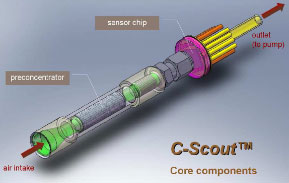A paper by Gary Marks of iP Solutions, “Opportunities for Demand Response in California Agricultural Irrigation: A Scoping Study” has just been published by the Demand Response Research Center (DRRC).
Category Archives: Consulting
Embedded Linux DSP System for Chemical and Radiation Threat Detection
iP Solutions brought extensive knowledge of Embedded Linux DSP systems hardware and software to the Nevada Nanotech Systems (NNTS) project for explosive chemical and radiation threat detection and analysis. The project, CScout, was targeted for shipping container security.
Previous experience with complex embedded control and data acquisition systems enabled iP Solutions to immediately begin contributing to this project. The primary goal was to design both hardware and software for using an NNTS Molecular Properties Sensor (MPS) to collect, analyze and present explosive chemical vapor threat data. Additionally, radiation spectrum data was to be collected and analyzed for any radiation threat components. This system was to be controlled and results communicated remotely through a wireless interface, the Maritime Asset Tag Tracking System (MATTS). Also, a hardwired network connection was to enable more extensive maintenance and engineering modes with web-based and terminal based interfaces.
The CScout system was successfully completed with impressive measurement results. This system will be used for demonstration of NNTS sensor capabilities to potential customers. Continue reading
Emerging Technologies Summit Presentation
Gary Marks of iP Solutions was invited to speak at the Emerging Technologies Summit in Pasadena, CA on October 15th, 2012. He presented “Opportunities for Demand Response in California Agricultural Irrigation” to the session titled “The Untapped Resource, Demand Response for the Industrial and Agricultural Markets”.
The Power-point Presentation
Invitation to Join DRRC Industrial Controls Experts Group
Gary Marks of iP Solutions corporation has been invited to join the Demand Response Research Center (DRRC) Industrial Controls Experts Group. On February 10th, 2011 the group met to consult on a study, “Assessing the Control Systems Capacity for Demand Response in California Industries”.
Precision Irrigation
iP Solutions announces the publication of “Precision Irrigation: A Method to Save Water and Energy While Increasing Crop Yield, a Targeted Approach for California Agriculture” by Gary Marks.
Crop irrigation requirements vary in time with weather and soil conditions. Precision
irrigation provides a means for evaluating a crop’s water requirements and a means for
applying the right amount at the right time. Often in the literature, precision irrigation is referred to as irrigation scheduling: That is scheduling based on environmental data, whether that data comes from local field sensors or from more global sources such as regional meteorological information.
Applying precision irrigation practices offers significant potential for saving water,
energy, and money. Further, it has the potential to increases crop yield. There is an
additional positive environmental impact from precision irrigation in that farm runoff, a major source of water pollution, can be reduced.
While precision irrigation has value for all types of irrigation in any region of the world, this paper focuses on the irrigation of California agriculture, which uses nearly 80% of the state’s water and more than ten billion Kilowatt hours of electricity annually. That is enough electricity to power one million typical American households each year. The approximate power plant capacity required to power California irrigation through the months of May through October is 2500 MW, which is equivalent to 250 Min-Nuke power plants running at an average of 10MW each. The carbon footprint associated
with the power is approximately six million metric tons of CO2 per year.

